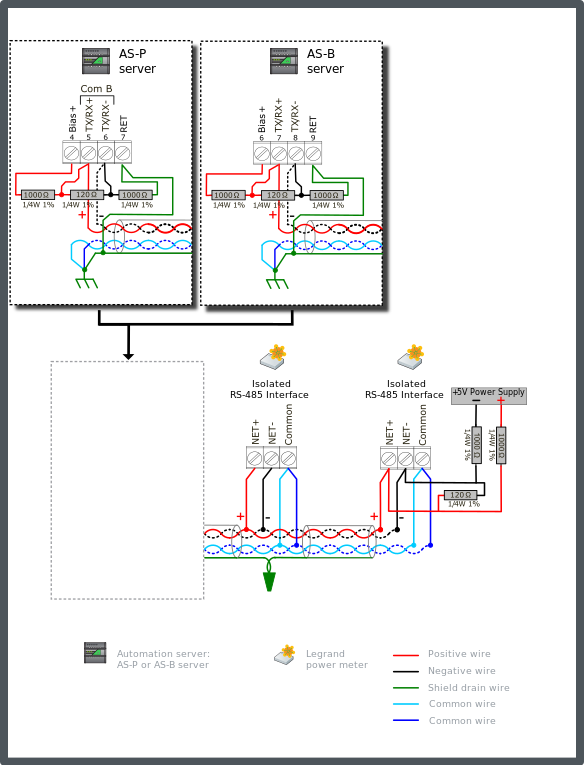
Concept
Legrand Configuration 4: Terminated Bus with Dual End-point Bias
A fourth configuration option is targeted at recovering the full 1200 m (4000 ft) capability of the RS-485 network while accommodating the standard 120 ohm End Of Line (EOL) terminations for better high speed data quality. This technique applies a 5 V bias at each end of the network. Biasing the network from both ends completely eliminates the dropping failsafe bias voltage as the cable length extends toward the remote terminator. This configuration option can be used for any combination of Legrand models 04677, 04680, 04684, or 14669.
With dual end-point bias, a strong and constant bias level is present over the complete length of the bus. The dual end-point bias uses a pair of 1000 ohm resistors at each end. This combined parallel resistance of 500 ohm still encounters the significant unit load reduction as with Configuration 3, but now supports the RS-485 maximum 1200 m (4000 ft) network length. For more information, see Legrand Configuration 3: Terminated Bus with Single End-point Bias .
When using an AS-P server or AS-B server positioned at the head end of the network, you can use the 5 V available on the Bias+ terminal to provide the head-end bias. You use an external 5 V DC power supply to provide the bias at the far end of the network. The recommended power supplies are discussed separately. For more information, see Power Supply Selection for Legrand Configuration 4 .
Connect a 1000 ohm bias resistor from the TX/RX+ terminal (see the figure below) to the Bias+ terminal on the AS-P server or AS-B server. Connect another 1000 ohm bias resistor from the TX/RX- terminal to the RET terminal on the AS-P server or AS-B server. Connect an external 5 V DC power supply to the RS-485 bus pair through two 1000 ohm bias resistors at the far end of the cable.
Connect the two RS-485 common wire pair and the shield to earth ground terminal rail in the panel with the automation server. This is the only ground connection of the shield for these conductors. The shield drain wire from the cable segments are twisted together and passed by each node.
Both conductors of the second twisted pair cable are used to connect RS-485 Common on the meters.
Use only twisted pair bus cable specified for use with RS-485 (for example, Belden 9842 or equivalent). For more information, see Cable Selection (Legrand Power Meters) .
The example diagram below shows the alternate RS-485 terminal block connections for the different automation server models.
The example diagram below shows the RS-485 Com B connections on the AS-P and AS-B servers. The guidelines are the same for Com A.

Each of the models 04677, 04680, and 04684 presents an RS-485 network load of 1.32UL, and the model 14669 has a network load of 1.75UL. The automation server has a network load of 0.5UL. To determine the number of nodes (meters) the bus will support, we first determine the remaining available unit load capacity after subtracting the base load of the automation server, and the load produced by the bias resistors.
For networks connecting only with Legrand meters, the initial unit load budget is 48UL. For networks with one or more other Modbus devices that are not isolated, the initial unit load budget is 32UL. The automation server has a unit load of 0.5UL. The dual 1000 ohm bias gives a unit load of 24UL (12,000 / 500). Subtracting these two loads from the initial budget gives a remaining capacity of 23.5UL (all isolated) or 7.5UL (mixed).
For isolated network, the calculated maximum node count is:
For models 04677, 04680, and 04684: 23.5 / 1.325 = 17.7 nodes (meters)
For model 14669: 23.5 / 1.75 = 13.4 nodes (meters)
For mixed network, the calculated maximum node count is:
For models 04677, 04680, and 04684: 7.5 / 1.325 = 5.6 nodes (meters)
For model 14669: 7.5 / 1.75 = 4.2 nodes (meters)
You can accommodate the load from a mixed combination of model 14669 meters and the others by simply summing their individual Total Unit Load values. For more information, see General Legrand Power Meter Properties . The maximum recommended limit is reached when that sum reaches 23.5UL (for all isolated) or 7.5UL (for mixed network).
 Legrand Power Meters
Legrand Power Meters
 Legrand Configurations
Legrand Configurations
 Legrand Configuration 3: Terminated Bus with Single End-point Bias
Legrand Configuration 3: Terminated Bus with Single End-point Bias
 Cable Selection (Legrand Power Meters)
Cable Selection (Legrand Power Meters)
 General Legrand Power Meter Properties
General Legrand Power Meter Properties